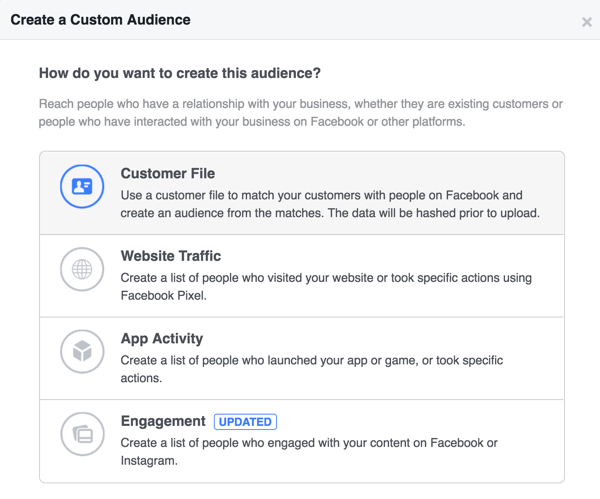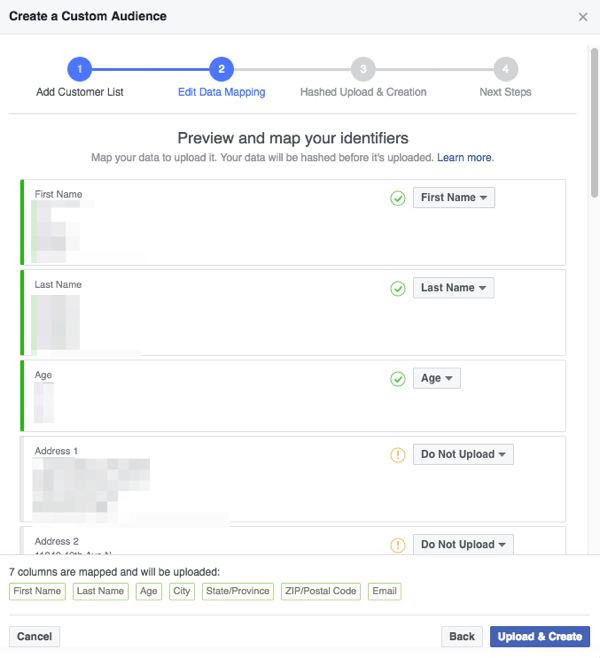 Do you want to reach people based on their physical addresses?
Do you want to reach people based on their physical addresses?
Have you considered combining Facebook ads with direct mail?
In this article, you'll discover how to create a multichannel marketing campaign using Facebook ads and direct mail.

#1: Prepare Your Mailing Data for Upload Into Facebook
If you use direct mail, your mailing data is valuable for marketing on Facebook, too. With the mailing data, you can show Facebook ads to your direct mail recipients who are also Facebook users. This approach is a great way to reach potential customers in multiple ways.
To begin, prepare your mailing data for import into Facebook Business Manager or Ads Manager by creating a CSV file. Your goal is to compile as much data as you can. Facebook allows you to target custom audiences based on several factors:
- Phone Number
- First Name
- Last Name
- City
- State/Province
- Country
- Date of Birth
- Year of Birth
- Age
- Zip/Postal Code
- Gender
- Mobile Advertiser ID
- Facebook App User ID
Because you're working from a mailing list, at minimum you should have names and zip codes; however, the more data you have, the better. You can create a CSV file in a spreadsheet program like Excel and include a header for each data point you have.

If you need help, you can download this example CSV file from Facebook. Facebook also provides details about how to set up the columns and data.
#2: Create a Facebook Custom Audience Based on Your Data
After your mailing data CSV file is ready, you can use it to create a custom audience. In Facebook, open Ads Manager or Business Manager. Then open the Audiences tool, which you might find by looking in the Frequently Used column, or by clicking All Tools and then looking under Assets.

To set up your audience, click Create Audience and select Custom Audience from the drop-down list. In the pop-up window that appears, choose Customer File.

When you're asked for your source, select Add Customers From Your Own File.

Next, you'll work through about four steps in Facebook to prepare to upload the data. To start, tell Facebook you want to upload a file and select the CSV file of mailing data you created. After the file is uploaded, you'll be prompted with a field mapping window. This maps the column headers in your CSV file to data categories that Ads Manager or Business Manager uses.
Go through the list and make sure Facebook recognizes and maps the fields you want to use to build your audience, ignoring the fields that aren't relevant. Again, use name and zip code at minimum, but email and anything more are better. Facebook says the more data you use, the higher the match rate.

Continue following the prompts through the upload process to hash (securely upload) your data and start processing your audience file. You're all set to start building the campaign. Depending on the size of your import data, it might take a little while for Facebook to build your audience.
Get World-Class Marketing Training — All Year Long!
Are you facing doubt, uncertainty, or overwhelm? The Social Media Marketing Society can help.
Each month, you’ll receive training from trusted marketing experts, covering everything from AI to organic social marketing. When you join, you’ll also get immediate access to:
- A library of 100+ marketing trainings
- A community of like-minded marketers
- Monthly online community meetups
- Relevant news and trends updates
#3: Set Up Distinct Landing Pages for Direct Mail and Facebook Ads
When you're combining direct mail with Facebook ads, you want to set up two landing pages on your website: one for the mailing and another for the Facebook ads. With two separate destinations, you can measure response to the two media (without parameters that will require you to put a confusing URL on your direct mail ad).
If you don't already have a tool to create landing pages without developer support, you might want to consider investing in one. If you plan to test paid media efforts in particular, being able to rapidly launch landing pages is crucial. Unbounce and Leadpages are affordable and easy to use.

Discover Proven Marketing Strategies and Tips
Want to go even deeper with your marketing? Check out the Social Media Marketing Podcast! Publishing weekly since 2012, the Social Media Marketing Podcast helps you navigate the constantly changing marketing jungle, with expert interviews from marketing pros.
But don’t let the name fool you. This show is about a lot more than just social media marketing. With over 600 episodes and millions of downloads each year, this show has been a trusted source for marketers for well over a decade.
On your landing pages, it's critical to include a conversion point. Although you may be looking for prospects to respond to your ad offline (for example, a mail-in rebate or in-store visit), getting them to the landing page to either transact or learn more helps you gather analytics about your campaign and optimize based on that data.

On your landing pages, a conversion point might be watching a video, downloading a coupon, or making a purchase online. These conversion points help you understand audience behaviors from the two media (direct mail and Facebook ads).
#4: Segment Custom Audiences for Facebook Remarketing
After your landing pages are set up, you can refine your targeting to high-value segments of your master mailing list, namely those who visited one of those landing pages but didn't respond to your conversion point by watching the video, downloading the coupon, or whatever you asked them to do.
To target these segments, you create two additional custom audiences. One audience targets “abandoned mailers,” or those who responded to your mailing offer but abandoned the action on the landing page. The other audience is “abandoned Facebook users,” or those who responded to your Facebook ads but left the landing page before taking action.
The process to create these audiences is similar to creating the first audience. Return to the Audiences tool in Ads Manager or Business Manager. You want to base each new audience on Website Traffic and set the audience parameter to People Visiting Certain Web Pages but Not Others.
Then you can specify what pages to include and exclude. In the Include section, select the URL of the landing page. In the Exclude section, you might specify a URL or a custom event.

If people see a thank-you page after they convert, select the URL of the thank-you page. You use the custom event option instead of the thank-you page URL if your conversion point isn't transactional. For instance, instead of making an online purchase or filling out a form, you want users to download a coupon or watch a video.
After you set up the parameters for each remarketing audience, give your custom audience a name and click Create Audience.
#5: Coordinate the Timing of Your Direct Mail and Facebook Ads
Timing the sequence of the mailer and then the Facebook ads is important. After the mailers reach homes, recipients need time to get an “impression” and then respond, abandon, or have enough recall so when they start getting served Facebook ads, they're more likely to react because the Facebook ad isn't their first interaction with your campaign.
Much of the delivery window for direct mail is dictated by the postage you pay and the destination. After you deliver your mailers to the mailing facility, allow 1-2 weeks for delivery to homes and response or abandonment. Then kick off your Facebook ads. If you're planning campaigns with multiple mailing drops, stagger your drops and update your creative accordingly.
#6: Align Creative to Your Audience
Before you start your campaign, you need to take one more step: creative! Campaign elements should have a similar look and feel across direct mail, landing page, and Facebook ads. This consistency aids recall and increases touch points across channels.

Also, make sure the content is relevant to each of your three audiences:
- Those who haven't visited the landing page but may have glanced at your mailing
- Those who visited your landing page but didn't convert
- Those who visited your landing page and converted
For a long campaign, mix up your copy and visuals to test different messages to your three populations. Try a soft ask to those who have received the mailing but haven't visited the landing page versus a more direct, urgent ask to those who responded to the mailing but didn't convert.
#7: Launch Your Campaign and Monitor Performance
The last step is to load your creative and turn on your campaign. Keep an eye on how frequently each ad is served and how your ads perform from click-through to conversion.
Depending on the size of your audience, frequency could be a challenge. You might need to throttle budget, manage daily ad serving, or rotate creative frequently. However, because the entire campaign isn't being served via Facebook, your ad rotations might be far less frequent.
Bonus Tip: If you want to get really fancy, you can add a third channel by including an email campaign for the same audience.
Conclusion
There you have it! With only a few steps, you've turbocharged your direct mailing efforts. With the help of another channel, you're on your way to creating a multichannel campaign, and seeing reach and conversions rise.
What do you think? Do you have upcoming campaigns that could benefit from combining direct mail and Facebook ads? If you've already tried blending the two, what were your results? Please share your thoughts in the comments.
Attention Agency Owners, Brand Marketers, and Consultants

Introducing the Marketing Agency Show–our newest podcast designed to explore the struggles of agency marketers.
Join show host and agency owner, Brooke Sellas, as she interviews agency marketers and digs deep into their biggest challenges. Explore topics like navigating rough economic times, leveraging AI, service diversification, client acquisition, and much more.
Just pull up your favorite podcast app, search for Marketing Agency Show and start listening. Or click the button below for more information.

